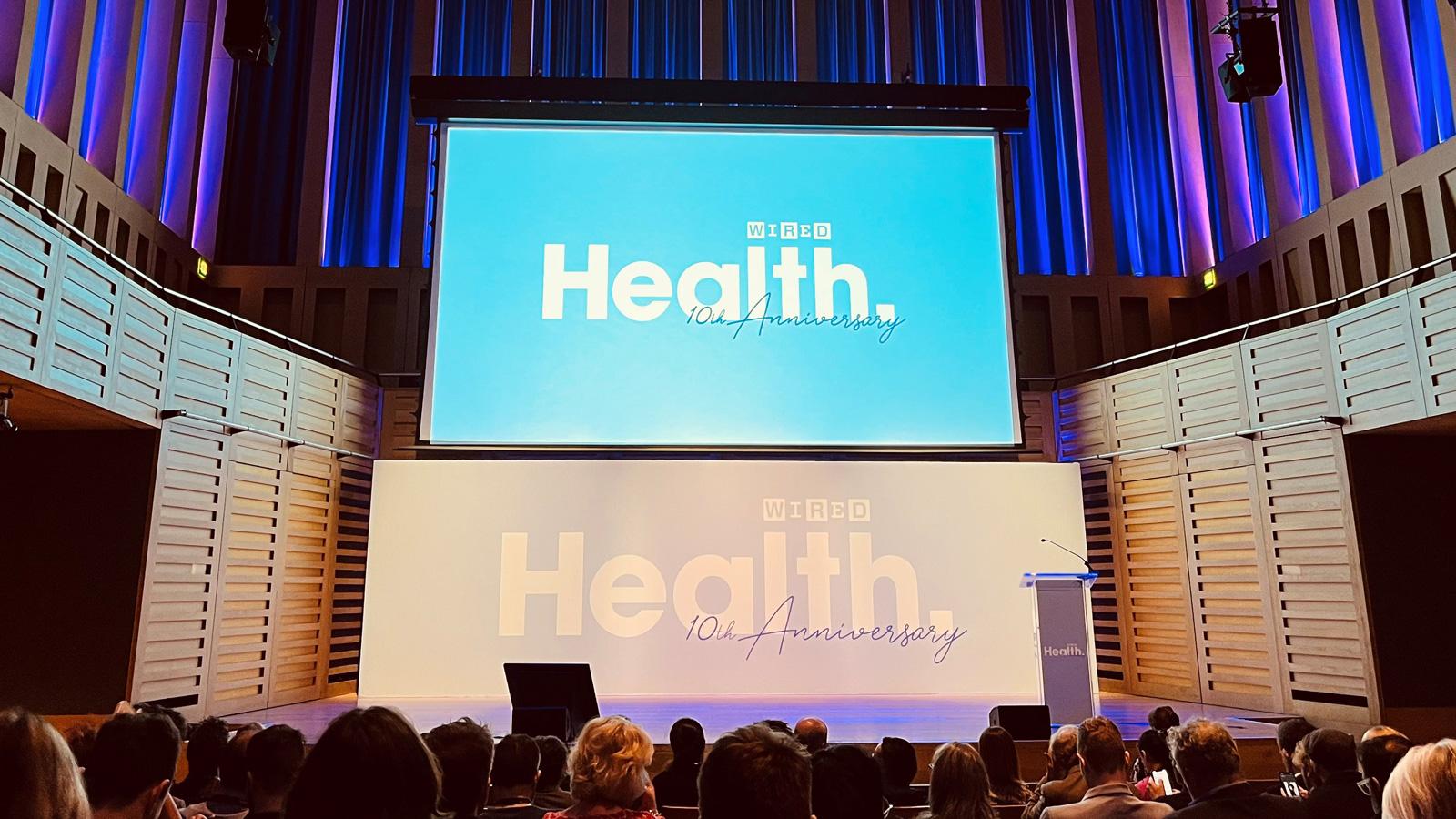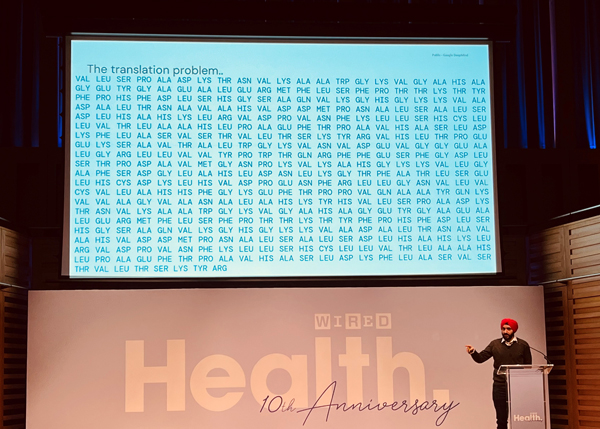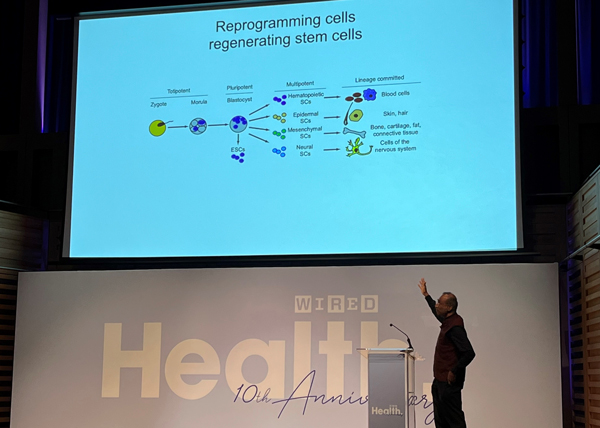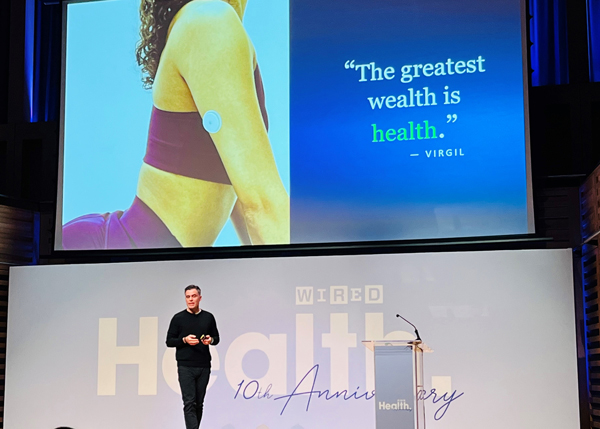Highlighting the disruptors: Innovation for now and tomorrow at WIRED Health 2024, Part One

On Tuesday 19th March, pharmaphorum headed to King’s Place, London for the 10th annual WIRED Health conference - an event partnered with EY, Boston Scientific, and Lingo this year, which seeks to highlight the most exciting and thought-provoking disruptors, scientists, and practitioners making a positive change in the way healthcare is both provided and accessed.
Neuroimaging, microdosing, the good versus bad debate when it comes to robots, the de-extinction of dinosaurs – these were topics posited in the opening video of the day, pre-emptive of Greg Williams, deputy global editorial director of WIRED’s keynote address, in which he advised that foundational research in AI for revolutionising understanding of the human body, and living a life both longer and healthier, would be central discursive points in the day ahead.
How AI is changing health and life sciences
From the day’s impressive list of speakers, Williams first introduced to the stage Pushmeet Kohli, VP of research at Google Deepmind, to discuss ‘How AI is changing health and life sciences’. Kohli should know: his team worked on AlphaFold.
Kohli addressed the ‘buzzword’ dismissive quality that is doing the rounds of late when it comes to AI and asked the audience to ‘come on board’ in understanding the place of this technology - without the hype.
Life is what is unique about the planet, said Kohli, and we have yet to encounter life elsewhere throughout the universe. But what is it that is so complicated and sophisticated about life? What are we, human beings, chemically? Well, the majority is water: “floating bags of water moving around in the world,” in Kohli’s terms. Yet, what is it that actually makes that ‘bag of water’ work? It is the building blocks of life, interactive molecules causing remarkable phenomena, including proteins.
One protein, however, can take a PhD’s worth of work - a single protein. Imagine, then, said Kohli, the whole richness of life in the world: there are billions of proteins and the full structure is yet to be understood. It had been a 50-year grand challenge in biology… And then came AI.

The protein in the graphic is essentially why we are all here. What AlphaFold was able to do was read the sequence and develop the structure. Which protein? you might ask. Haemoglobin: if it doesn’t work, we don’t exist. And AlphaFold? Well, it’s had an incredible impact in less than two years, with 1.7 million users of the database, in over 190 countries, with over 5 million structures viewed and cited over 18,000 times. Or, as Kohli said, think about it: there are 1.7 million people who really care about proteins!
Of course, the applications affected by AlphaFold’s technology extend beyond proteins, spanning plastic pollution, antibiotic resistance, structural biology, neglected diseases, malaria vaccination, and drug delivery. Indeed, AlphaFold has, it is fair to say, accelerated research, expanding what people can do and democratising scientific research in the process, especially for those in developing countries. Now, with a click of a button they can go to the database and access the predictions for free.
In short, with AI and machine learning, there are now available the tools to comprehend the system we call life. Not only life on this planet, but how humans fundamentally work.
To conclude, Williams asked Kohli about RNA and all he had been describing: “It’s about deciphering a sophisticated language,” replied Kohli. “You buy the book, but you don’t know how to read it – that’s the current state of affairs. Therefore, the database is like Google Translate, but for life.”
And what next? The hard genome: the most sophisticated language that nature has evolved, as Kohli terms it, capturing both complexity and sophistication.
“[We] don’t know how to understand that language,” he said. “It is magical. If you see a child develop from a small entity to grown up human, the amazement of how life works, the magic, is in that and in the hard genome.”
The right to clean air
To follow was a fireside chat between Rosamund Adoo-Kissi-Debrah CBE, founder of the Ella Roberta Foundation, and Williams, discussing ‘The right to clean air’.
In 2022, the Clean Air (Human Rights) Bill – otherwise known as Ella’s Law, named after Adoo-Kissi-Debrah’s daughter Ella, who became the first person in the UK to have air pollution listed as a cause of death following a fatal asthma attack aged nine in 2013 – was introduced and passed in the House of Lords.
Asthma afflicts a quarter of a million children in London. Yet, UK targets are not in line with World Health Organization (WHO) targets, noted Adoo-Kissi-Debrah. Included in the UK Government’s Environment Act is the target to “reduce exposure to the most harmful air pollutant to human health – PM2.5 – by over a third compared to 2018 levels”. Particulate matter (PM) is, according to the Gov.uk website, “everything in the air that is not a gas and therefore consists of a huge variety of chemical compounds and materials, some of which can be toxic.” PM is classified by size, with PM2.5 meaning the fractions of PM where particles are less than 2.5 micrometres in diameter.
The Environmental Targets (Fine Particulate Matter) (England) Regulations 2023 require that, in England by the end of 2040, the annual average of 10μg/m3 for PM2.5 not be exceeded at any monitoring station and that “population exposure to PM2.5 is at least 35% less than in 2018”.
But these regulations have come about only through campaigning; and through disruptors like Adoo-Kissi-Debrah.
So, what were the first signs of Ella’s health condition? She had been a 41-week pregnancy, and a healthy baby, had all her immunisations, and had not been a sickly child. Then, her first hospital visit came in 2010, with a severe cough and coughing syncope, which is more common in long-distance lorry drivers. Her GP records showed no warning signs and there was a struggle for diagnosis. Meanwhile, she started experiencing hypoxic seizures and had one of the worst cases of asthma recorded; brittle asthma, which is extremely rare. During a bronchoscopy, her lungs had shut down, and she had found herself in the ICU five times altogether, before passing away three weeks after her ninth birthday.
The link with air pollution, however, wasn’t made until after her death, said Addo-Kissi-Debrah. A coroner’s officer was looking into her case and they brought in a medical expert to look at the samples from her daughter’s body that Addo-Kissi-Debrah had, she said, for some reason felt she had to make sure were taken. During an interview for a local newspaper on the anniversary of Ella’s death, she had asked generally if anyone out there could help: and a man wrote in and told her to check the air pollution around the house at the time. So, she found an expert and, indeed, 27 out of the 28 times Ella’s health had gone down, a pollution peak was occurring.
Ella’s Law is soon to be proposed for a second time. If passed, it will serve to prevent other such pollution-related deaths. Indeed, the Gov.uk website states that “air pollution is the biggest environmental threat to health in the UK, with between 28,000 to 36,000 deaths a year attributed to long-term exposure.” It is also widely documented that “there is strong evidence that air pollution causes the development of coronary heart disease, stroke, respiratory disease and lung cancer, and exacerbates asthma.”
Why we die and the quest for immortality
Following a short coffee break, the next part of the day was introduced by WIRED’s curator, João Medeiros, who welcomed Venki Ramakrishnan, author of “Why we die” (a deep dive into the science of ageing), on stage to discuss ‘The quest for immortality’.
If you’re a mayfly, Ramakrishnan began, you live about a day, while butterflies can live a week or sometimes months. A Galapagos tortoise, by contrast, can see out 150 years, and a Greenland shark about 400 years or so. In short, the larger you are, generally, the longer you can expect to live as a species. And evolution optimises for fitness: if small, there’s no point in spending resources to maintain and repair the body to stay alive longer, as you will be eaten before then, he said. Being larger permits time to find a mate and produce offspring over a longer period, as well. Also, smaller animals have a higher metabolic rate and don’t live as long; almost burning out, if you will. And wider ranging animals live longer than terrestrially trapped mammals, too.
Meanwhile, as their name probably suggests, immortal jellyfish don’t age at all. Rather, they can go backwards in development, like a butterfly becoming a caterpillar again.
All interesting and good to know. But what applicability to humans? The ongoing search for ‘immortality’.
Frenchwoman Jeanne Louise Calment (1875-1997) lived to the grand old age of 122 – that, despite consuming 2.5lbs of chocolate a week, and enjoying a glass of port and a cigarette every day. That anomalous case aside, perhaps, the number of centenarians alive today is growing due to improvements in healthcare, but for some reason the proportion of those living over 110 years of age is not increasing. So, the question is: is there a natural biological limit?
There is, as has been widely spoken about of late, a growing ageing population the world over and the problem that is clear is how to keep all those older people healthy, productive, and independent for as long as possible. There have been over 300,000 papers published in the past decade, and some 700 start-ups have tens of billions of dollars invested in the area, said Ramakrishnan.
While recommendations for nutraceuticals might have exploded and a trend for lengthening telomeres appeared (“Just go to Amazon!” he joked), there is no FDA approval. There might be a movement in support of caloric restriction and there are drugs that mimic this, but there are side effects. Then, there is the practice of shared circulatory systems: begun about 50 years ago, it was found if you connected two animals and had them share their circulatory system, the blood from the younger would alleviate signs of ageing in the older animal. So it is that some companies jumped the gun and offered plasma from young to old – which tech billionaire Bryan Johnson, for instance, quickly and eagerly participated in.
Another big area of research is in targeting senescent cells: they don’t divide and actually secrete inflammatory compounds. And then, of course, there are stem cells.

Shinya Yamanaka won the Nobel Prize for Physiology or Medicine in 2012, together with John Gurdon, for the discovery that mature cells can be converted to stem cells – literally, have an adult cell go backwards in development, as far back as a pluripotent cell. But there are risks, explained Ramakrishnan, and it is one of those things that is exciting, promising in terms of innovation, but which needs to be looked at very carefully.
The trinity for health, then, is the old one: sleep, exercise, and diet. Each of those affects the other two; a virtuous cycle. If done all at once, they work better than any medicine on the market, with no side effects, and free of cost. Nonetheless, it doesn’t work for everyone, himself included: despite adhering to the health trinity, he has high blood pressure and high cholesterol, and has to take medicine.
So, he left attendees to ponder, how does one take prevention to the next level when there is a clear difference in the effects of ageing between one individual and another?
A health pyramid: AI, biowearables, and behaviour
Following on, Olivier Ropars, divisional VP of Lingo at Abbott, gave the presentation ‘A health pyramid: AI, biowearables, and behaviour’.
“The greatest wealth is health,” Virgil once declared, and surely the majority would concur. But average life expectancy in the UK is 82 years and actual ‘health span’ is only 63 years – that is to say, it’s not a centenarian population and is, rather, one in which those over the age of 60 can instead expect two decades of living with medical issues before death. Experts are already warning also that children will have an even lower life span. Not a desirable prognosis.
So, Virgil’s declaration seems on the money, so to speak: it is about health span, as much as life span. However, the Centers for Disease Control and Prevention (CDC) reported that 80% of chronic diseases are through lifestyle, said Ropars. Today, we are far more sedentary, whether at a desk, at a conference, in cars, or in airplanes. Everything today requires a lot less physical effort and there is an abundance of food 24/7 to exacerbate matters, providing not nurtriture, but ‘murtriture’, and this makes adopting a healthier lifestyle a challenge. Furthermore, healthcare systems are designed for sick care - health is instead what happens between doctor’s visits.
Clearly, the situation is not sustainable. But how to bring the wealth of health back to the population at large?
Two years ago, Ropars himself – a slimline and athletic figure – was diagnosed with pre-diabetes. Needless to say, it was a shock. He is active, he eats well. He has, he admitted, a sweet tooth, but surely that was not such a big issue? ‘It’s not you, it’s your pancreas,’ the doctor had told him. Ropars was, apparently, just getting older: he should eat healthier and exercise a bit more. Indeed, most if not all of us are aware that changing our diet is the most prevalent solution – but it doesn’t work for everyone. The very biology of human beings does not permit a ’one-size-fits-all’ approach.
We are all unique and need personal insights, need a strong support system to make changes. And so, to biowearables: personalised consumer health utilising behaviour science and artificial intelligence. Like a window into the body, a biowearable makes the invisible visible.

Such is Abbott’s Lingo, translating the language of the body. With the power of AI, applying behavioural science, Lingo (which some will find reminiscent of Zoe) provides metabolic insights, areas of concern, and challenges – a personal metabolic coach, if you will. The first focus is glucose because it is a critical marker for everyone: Alzheimer’s is, after all, nicknamed ‘Type 3 diabetes’. Other biomarkers like ketosis and lactase will be focused on next. But the biowearable provides a strong opportunity to support lifestyle behaviour change.
Questioned by Medeiros about its suitability for those with eating disorders, Ropars advised that it is not recommended that those with anxieties about food circumvent physicians to use such a biowearable as Lingo.
The second part of pharmaphorum’s coverage of the 10th WIRED Health conference will be coming soon.












